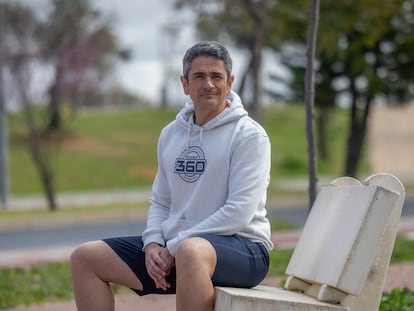Hollywood has ‘Ozempic face’: Why you can look 10 years older after going all in on the slimming drug
The semaglutide craze is a global phenomenon, but among its unwanted side effects is a premature aging of the face. Health professionals have found themselves administering anti-aging treatments to an ever-younger clientele

Catherine Deneuve warned us when she herself was approaching 60: “At a certain age, you have to choose between your face or your ass.” A half century later, judging from the latest red carpets, it’s easy to tell that Hollywood has opted for the latter. At the Oscar gala earlier this month, host Jimmy Kimmel delivered the gag of the evening: “Everybody looks so great. When I look around this room, I can’t help but wonder ‘Is Ozempic right for me?’”
The comedian was referring to the current craze for semaglutide, a medication designed to treat type 2 diabetes and obesity that requires a doctor’s prescription, and that many people (and not just celebrities) are using to benefit from its famed side effect: loss of appetite and subsequent speed-slimming. Media coverage of the evening’s red carpet splashed the subject across a variety of publications: “Which of Oscars 2024 stars may or may not have used Ozempic to cut weight for Hollywood’s biggest night,” read a headline in The New York Post, which concluded that America Ferrera and Brendan Fraser may have used the drug. The Financial Times wrote about the dangers of “living in an Ozempic world.” It was the subject of much discussion on social media, with endless users posting about prescription slim-downs. “Ozempic brought a different dimension to the Oscars red carpet this year,” claimed The Sydney Morning Herald. Paris Match also devoted space to the stars’ “pilule magique.” “Forget Chanel, Dior or Prada: This year, the most prominent designers on the red carpet are Novo Nordisk and Eli Lilly, whose injectable weight-loss drugs are the new couture,” announced famed newsletter on Hollywood’s cultural impact, The Ankler.
Days before the awards ceremony, Eli Lilly, which currently manufactures two medications that compete with Ozempic — Zepbound for obesity and Mounjaro for diabetes — premiered a commercial that complicates the rapid weight-loss narrative: “Some people have been using medicine never meant for them. For the smaller dress or tux, for a big night, for vanity. But that’s not the point. People whose health is affected by obesity are the reason we work on these medications. It matters who gets them.”
Hollywood has clearly gone in on the express ass option, and to obtain it, as per the warning of Deneuve, it has run into a danger of which the rest of the world was already aware: when we slim down the body too fast, we lose youthful elasticity in the face. Ozempic has made a splash on red carpets, but in reality, it is a global phenomenon — and business is booming. Sales numbers confirm that Novo Nordisk’s operating profits grew by 58% since 2017, the year that it introduced Ozempic. Those figures are growing in part thanks to people without a history of diabetes, and in particular, a younger demographic. According to Komodo Health, a company that tracks data related to medical treatment for 330 million U.S. patients, among people without diabetes who have been prescribed Ozempic or Mounjaro, nearly 40% are between the ages of 25 and 44.
As Novo Nordisk, the pharmaceutical creator of Ozempic, would have it, the drug is “an injectable solution in a pre-filled pen.” Its active ingredient is semaglutide and “it helps your body to reduce its blood sugar levels when those levels are overly elevated, and it can help to prevent cardiac illness. Ozempic is used to treat adults (from 18 years of age) with type 2 diabetes, when diet and exercise are not enough.”
For diabetics, the drug reduces blood sugar levels. But it also impacts appetite, which means that when you start injecting it, the pounds begin to drop off. That’s why many people who are not necessarily diabetic or obese are using it to slim down. In Spain, Social Security pays for the medicine when it is prescribed by a doctor in certain cases at a price of four doses for $4.59, though many opt for private healthcare, despite its higher price point: $141 for the same number of doses.
This isn’t just changing many individual’s figures, but also their face, the way that we perceive beauty and the future of aesthetic medicine.

Sag and flab of the Ozempic face
The most common motivator for people who use semaglutide for aesthetic reasons is loss of appetite: Ozempic gives the feeling of being forever full, so that you can say goodbye to snacking, and be satisfied with smaller portions of food. Soon, though, nausea, vomiting, diarrhea or constipation can appear. After a few months, the “Ozempic face” may show up in the form of prematurely aged skin.
In a 2024 article about plastic surgery trends, Allure analyzes how the “Ozempic face” is changing the kinds of aesthetic surgeries that patients are seeking out, and the ways in which doctors provide them. It says that many patients who have never undergone a facelift are seriously considering them, and that 20-somethings are asking for procedures that were designed for people over 50 due to flaccidity, sagging and loss of facial volume.
We spoke with five doctors about how Ozempic is changing faces, and the way that we approach beauty.
In reality, Ozempic has just put a new name on the pre-existing practice of sudden weight loss. “It’s a term that has been used in various articles to refer to the facial skeletization that can be generated after loss of significant weight, from at least 17 to 22 pounds,” explains aesthetic doctor Mar Mira, who is the co-director of Madrid’s Clínica Mira+Cueto. According to Mira, our face contains different structures, among which are deep and superficial fat compartments, which decrease with any kind of overall weight loss, not just drug-assisted slimdowns. “It is always more evident in thin faces that have seen significant weight loss, since in overweight or obese patients, weight loss does not usually result in significant facial skeletonization. However, shadows underneath the cheeks may be accentuated by reabsorption of fat compartments, and facial flaccidity can become more pronounced around the jowls and jaw line due to the loss of temporal and preauricular fat compartments, which are usually the first to be reabsorbed during the aging process.” The doctor says that patients who come to her office with these concerns say that their appearance “starts to look tired, or that sagging has become accentuated.”
“The problem is not losing weight: it’s doing it all at once”
As Dr. Celia Gonzalo, a physician specializing in endocrinology and nutrition at Neolife Medical Group, explains to EL PAÍS, “sudden and significant decrease in facial fat can accentuate expression lines, cheekbones and also cause sagging in the cheek area. In short, for some people it can result in an older-looking appearance.”
“Loss of facial volume can be one of the signs of aging given that, as we get older, we have less capacity for cellular regeneration, the musculoskeletal system changes, muscle mass and bone density decreases, as does collagen and elastin production, which leads to changes in our skin, like a loss of smoothness and ability to hold up internal tissues as well as the appearance of wrinkles,” says Dr. Gema Pérez Sevilla, a maxillofacial surgeon and expert in facial aesthetic medicine, who has a clinic in Madrid. “Major weight loss affects the whole body, including the face, and can definitely impact volume in the jowls and cheeks, among other places.”
This is what Deneuve meant when she said one had to choose: when we lose a lot of volume in the body, our face can follow suit, aging our appearance. “Indeed, with marked volumetric deficits, we go from a healthy, youthful-looking face to a skeletonized face. In a skeletonized face, facial fat (which forms the face’s cushioning) atrophies and bony ridges are accentuated. This conveys the appearance of fatigue through the sinking of the cheek at the anterior level, and can sometimes convey sadness. Temples are sunken, and flaccidity can progress, rotating facial structures and leading to a greater degree of sagging. All this makes us look older and can impact our appearance,” says Mira.
“Losing weight quickly and at an advanced age makes it so that the dermis cannot recover from new physical conditions. It is very important to lose fat healthily and accompany the process with a healthy diet and exercise, always under the supervision of a health professional,” says Dr. Irene Cruz, a surgical doctor who specializes in advanced aesthetic medicine and nutrition, and who is a member of the medical team at the Instituto De Benito, which has locations in Madrid and Barcelona.
Fluctuations in weight are a recurring subject for many aesthetic medicine patients who are looking to refresh their appearance. “Loss of volume means less support and subsequently, adjacent structures can sag more intensely. All this leads to accelerated aging due to the folds and wrinkles that appear, and a loss of luminosity in the face. In search of solutions to this problem, young people who are seeing these factors at an earlier age, who would have normally sought us out 10 or 15 years later, do seek treatment from us,” says Dr. Moisés Amselem, an aesthetic physician who specializes in facial rejuvenation at his clinic in Madrid.
Sign up for our weekly newsletter to get more English-language news coverage from EL PAÍS USA Edition









































